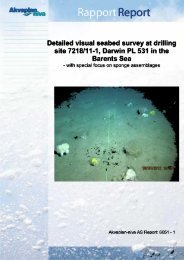A study of the priority substances of the Water Framework Directive ...
A study of the priority substances of the Water Framework Directive ...
A study of the priority substances of the Water Framework Directive ...
You also want an ePaper? Increase the reach of your titles
YUMPU automatically turns print PDFs into web optimized ePapers that Google loves.
..:::::::::: mercury and its compounds<br />
..:::54<br />
21 Mercury and its compounds<br />
� Mercury is a widely used toxic heavy metal<br />
which has been used in measuring instruments,<br />
switches, lights, dentistry, anti fouling in paints,<br />
batteries and chloro-alkali industries.<br />
� Mercury is found in significant levels in fresh<br />
water fish in Norway.<br />
� There is no fur<strong>the</strong>r need for screening, but<br />
Inner Osl<strong>of</strong>jord should be fur<strong>the</strong>r investigated.<br />
Production and use<br />
Globally, mercury has been used in dentistry,<br />
measuring and control equipment, batteries and<br />
lamps. The chloro-alkaline industry is also<br />
known to use large amounts. Mercury has also<br />
been used as a pesticide and biocide on grain<br />
and in paper industry. In Norway, most use is<br />
banned or restricted. Currently, Hg is found in<br />
old electrical appliances, amalgam in teeth and<br />
in lights (tubes, energy saving light bulbs and<br />
headlamps on cars). In connection with <strong>the</strong><br />
phasing out <strong>of</strong> PCB in road lightning, Hg road<br />
lights all over Norway are <strong>of</strong>ten substituted<br />
with Na (sodium) lamps.<br />
Emissions, discharges,<br />
distribution and hot-spots<br />
Mercury has not been mined in Norway, but<br />
<strong>the</strong>re has been a limited production as a byproduct<br />
at Norzink, Odda in Hordaland<br />
County.<br />
According to SFT, 1 100 kg Mercury was emitted<br />
in 2002. Main emissions were from land<br />
based industry (41 %), transport (26 %), amalgam<br />
(18 %), waste management - incineration<br />
and landfills (7 %), oil and gas industry (3 %)<br />
and o<strong>the</strong>r (5 %). There has been a 58 % drop<br />
in emissions since 1995.<br />
Discharges to water have dropped from 1174 to<br />
appr. 65 kilos in 2002. Emissions to air have<br />
dropped from 1400 kg in 1990 to 640 kg in<br />
2003. Imported mercury in product has<br />
dropped from 3600 kilos to about 40 kilos in<br />
<strong>the</strong> same period. Drop in emission to air is<br />
caused by reductions from incinerators and crematoriums,<br />
from oil and gas sector and landfills<br />
and by reduction from industrial sources <strong>of</strong>ten<br />
due to closing <strong>of</strong> plants. Drop in discharges to<br />
water are mainly caused by lower emissions<br />
A <strong>study</strong> <strong>of</strong> <strong>the</strong> <strong>priority</strong> <strong>substances</strong> <strong>of</strong> <strong>the</strong> <strong>Water</strong> <strong>Framework</strong> <strong>Directive</strong><br />
TA-2140/2005<br />
FACTS<br />
Cas no.: 7439-97-6<br />
Synonyms: Kvikksølv. HgS: Cinnabar H2Cl2: Calomel,<br />
CH3-Hg methyl mercury (most toxic).<br />
Properties: Heavy silvery liquid.<br />
Toxic effects: Mercury and mercury compounds are<br />
toxic. It causes damage on inner organs and is very<br />
toxic to aquatic organisms. Both short-term and longterm<br />
exposure to mercury in humans may result in<br />
central nervous system (CNS) effects. Inorganic mercury<br />
accumulates within <strong>the</strong> brain, causing CNS<br />
effects. Organic mercury has high lipid solubility and<br />
is distributed throughout <strong>the</strong> body, accumulating in<br />
<strong>the</strong> brain, kidney, liver, hair, and skin. Some compounds<br />
are suspected carcinogen (methyl mercury),<br />
and teratogenic. Mammals and aquatic organisms<br />
accumulates mercury (HSDB, CIRCA).<br />
Log Kow: -<br />
Persistence: -<br />
<strong>Water</strong> solubility: Insoluble to 63,9 µg/l<br />
Molecular formula: Hg<br />
Metabolites: -<br />
from <strong>the</strong> oil and gas sector and from dentistry.<br />
Estimates for concentrations in municipal waste<br />
are 1-1,5 mg/kg (EU). Long range transboundary<br />
air pollution contributes significantly to<br />
mercury pollution in Norwegian environment.<br />
Three main hotspots are former chorine-production<br />
plants at Herøya, <strong>the</strong> landfill Opsund in<br />
Sarpsborg, and a sunken German WWII submarine<br />
outside Fedje near Bergen. Emissions from<br />
smelters due to Mercury pollution in raw materials<br />
have created local high Mercury levels<br />
around Eramet Porsgrunn, Eramet Sauda,<br />
Tinfos Øye, Boliden Odda and Fundia Rana.<br />
High concentrations are expected to be found in<br />
sinks in older hospitals and at dentists. Finally,<br />
minor hotspots may be found downstream from<br />
old pulp-plants.<br />
Monitoring<br />
Monitoring <strong>of</strong> mercury has been part <strong>of</strong> JAMP<br />
and RID. Time trends exist. Mercury has also<br />
been investigated in several o<strong>the</strong>r studies (see<br />
references).

















